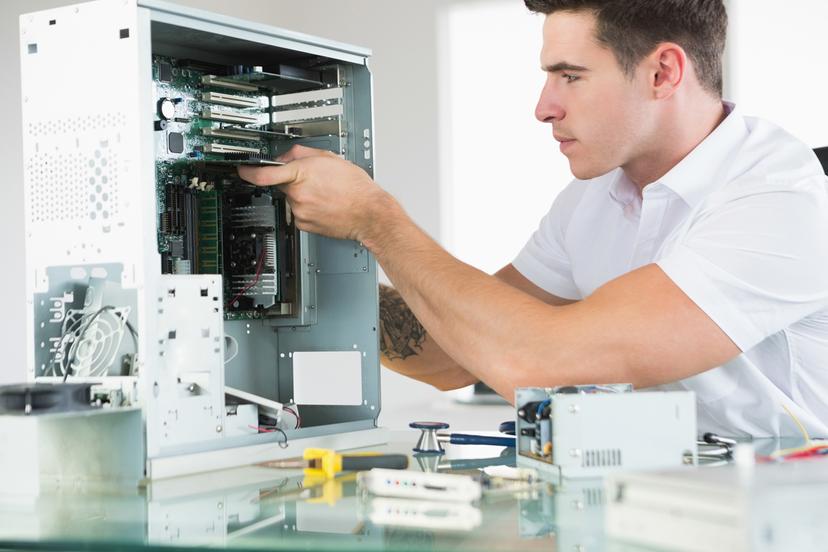Computer Hardware

Structure
Computers have proven to be an almost indispensable tool for business, as well as for home use. While most computers are made by large, well-known companies, other companies that are often smaller and less well-known play a role in the computer hardware industry.
Computer peripheral manufacturing companies design, develop, and manufacture the peripheral and related products that make the actual use of computers possible. These include keyboards, mice, and monitors, as well as products used to expand the functions of computers, such as printers, external hard drives, USB flash drives, wireless Internet cards, speakers, scanners, web cameras, and others. Many of these peripherals are made by small companies and sold locally or on Internet Web sites. Often, large companies purchase peripherals from smaller companies and assemble them as part of the computer. This results in many finished computers being the combination of a number of products.
Companies related to the computer hardware industry segment that produce peripherals also include communications equipment manufacturing, which produces cell phones and other devices for communications; semiconductor and component manufacturing, which produces computer microchips and circuit boards; and navigational, measuring, electromedical, and control instruments manufacturing, which produces consumer products such as global positioning systems or devices used by the medical and health care industries.
These companies, large and small, have created a wealth of jobs for both the hardware and software sides of the industry. Job titles and descriptions are constantly evolving in this field, the result of rapidly changing technology and industry demands. However, the main professional occupations in the computer hardware industry are computer scientists, computer engineers, systems analysts, and support workers; all can be further divided into specific specialties. Each group is involved in the design, manufacturing, and implementation of computer hardware systems, as well as computers and their components and peripherals.
Computer scientists design computers, develop new information technologies, and find new applications for computers. The Department of Labor (DOL) reports that 31,700 computer and information research scientists worked in the United States in 2018. They are employed by the academic professions to program computer languages, research new computer theories, and develop new hardware. Computer scientists may also work for private industries developing languages or tools, creating new systems, or designing computer games. In general, computer scientists are regarded as possessing a higher level of computer theory and expertise than computer engineers and systems analysts.
Computer engineers design, build, and test computer hardware, such as computer chips and circuit boards, as well as computer systems and software. They also work with peripheral devices, such as printers, scanners, modems, and monitors. There are many different types of computer engineers. Approximately 64,400 computer hardware engineers were employed in the United States in 2018, according to the DOL. Development engineers staff the research and development departments of computer firms. Their purpose is to come up with new product ideas, their functions, and applications.
In some companies, systems analysts may also play a part in the design process. Systems analysts plan and develop new products or revamp existing technology and systems to meet the specific demands of a business or organization, compared to engineers who may not have a target market, or client, in mind. Many times, systems analysts oversee the entire production process from start to finish. Approximately 633,900 computer systems analysts worked in the United States in 2018, as reported by the DOL. They are employed by a variety of companies specializing in business, accounting, science, or engineering, among others; most analysts have a bachelor’s degree in computer science.
As part of the design process, system analysts, or design engineers, or a team of both, design each component and then assemble and test each new product. They evaluate effectiveness, cost, and reliability, among other factors, before pursuing the project. Computer-aided design (CAD) programs automate three-dimensional designs that engineers can manipulate when experimenting with different drafts of a potential product.
Once the product design is completed and approved, computer production engineers supervise the manufacturing of the hardware product. They evaluate the manufacturing process, or the equipment used, to make production more efficient and cost effective. Production engineers and their staff implement any necessary changes. Quality assurance engineers monitor the production process to make sure the hardware product is made properly and flawlessly. The new, or improved, hardware product is now ready for use.
Computer sales representatives sell computers and related hardware and peripherals to businesses or individual customers for home use. System setup specialists are often needed by businesses to install new computer systems or evaluate and upgrade existing ones. They also offer technical support and training to computer users. Computer service technicians test, repair, maintain, and install computer equipment.
Technical writers are important to the computer hardware industry because they create a bridge between computer companies and the ultimate end users of the product, the customers. Technical writers produce user manuals, installation guides, and tutorials in a concise format and layman’s language that is easy for nonspecialists to understand and follow. Besides simplifying technical language and coding, technical writers also test documentation against the actual product. In 2018, about 55,700 technical writers worked in the United States, according to the DOL.
Computer support specialists, also called help desk technicians, are employed by companies or organizations to provide assistance and support for computer hardware users, as well as software and system users. The DOL reported that there were nearly 863,100 computer support specialist workers employed in the United States in 2018.
